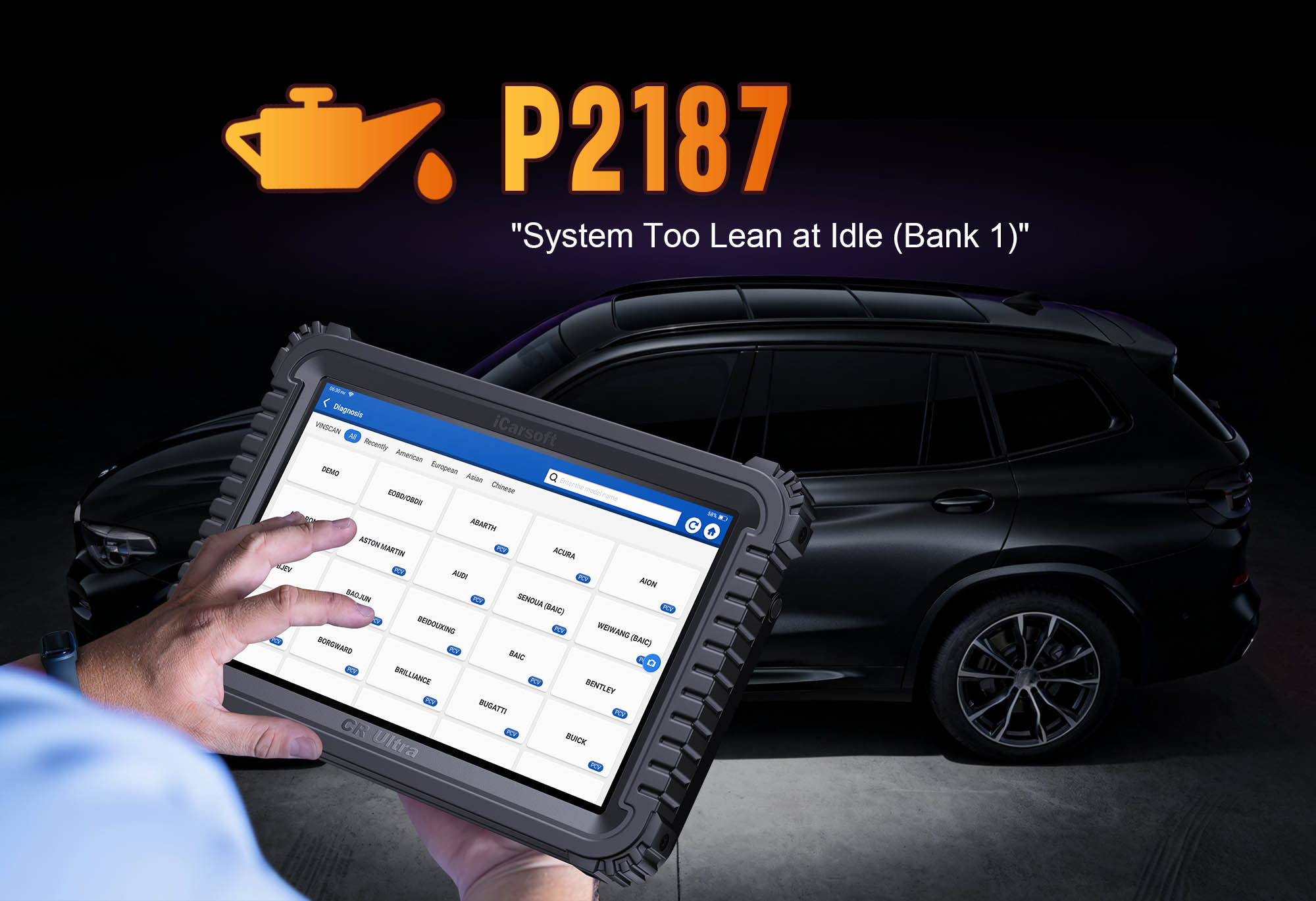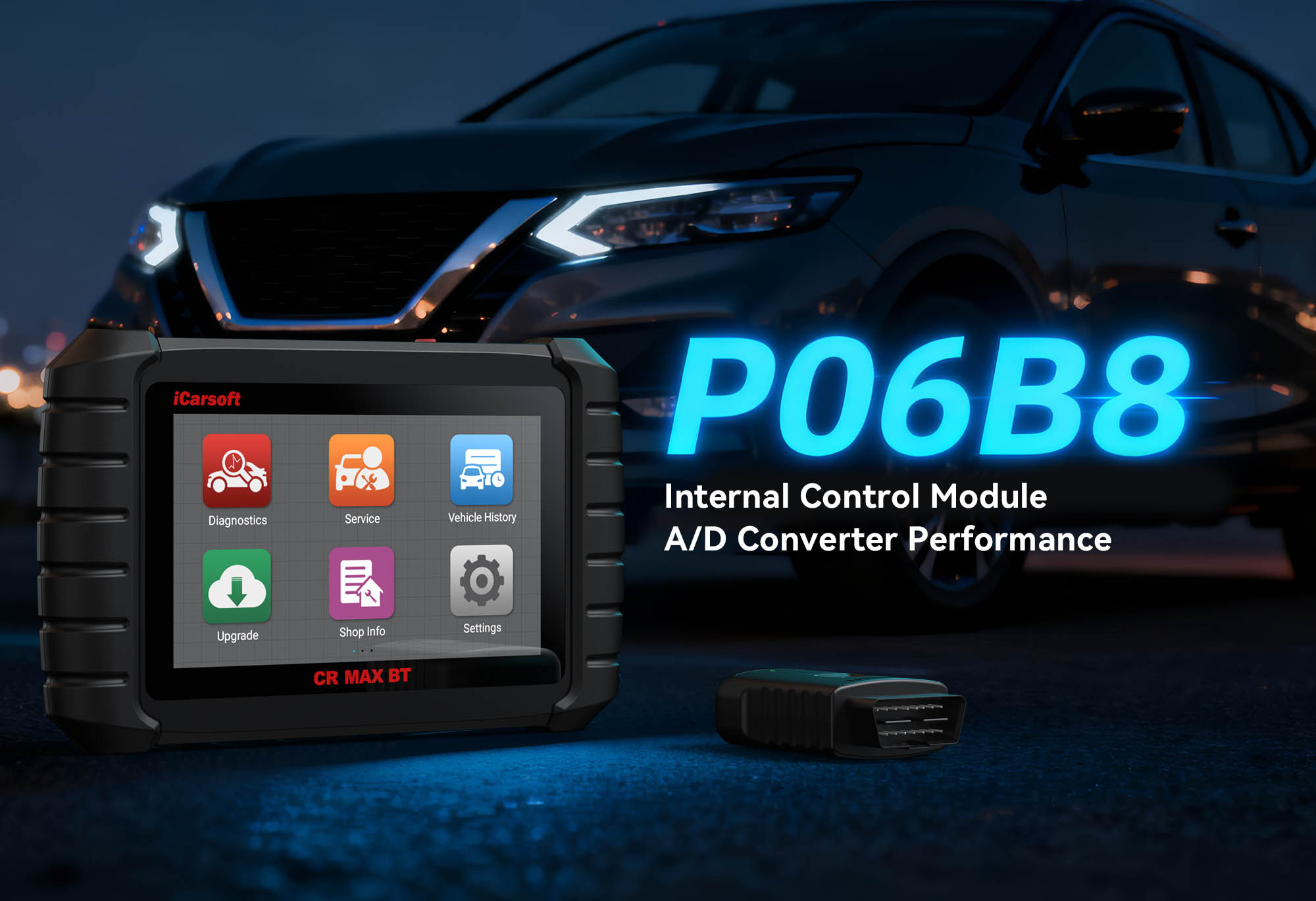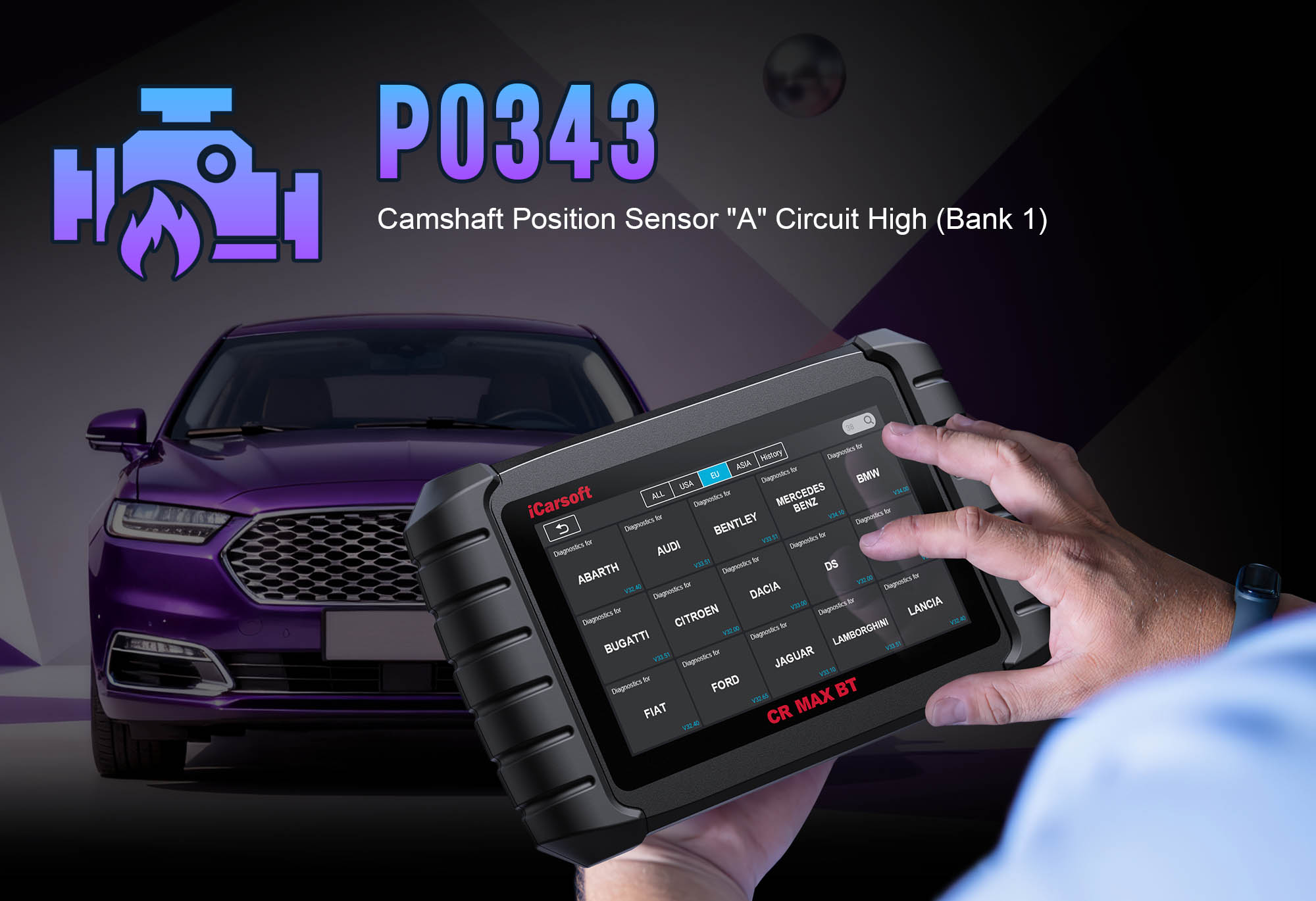Diagnose & Clear P2187 with iCarsoft CR Ultra: Fix System Too Lean at Idle (Bank 1)
If your check engine light illuminates and you notice rough idle, hesitation when accelerating from a stop, or increased fuel consumption, a diagnostic scan will likely return P2187. This OBD-II code stands for "System Too Lean at Idle (Bank 1)," indicating the Engine Control Module (ECM) has detected an abnormally high air-to-fuel ratio in Bank 1 (the cylinder bank containing cylinder 1) during idle—typically above the ideal 14.7:1 ratio.
A lean condition occurs when the engine receives too much air relative to fuel, disrupting combustion efficiency. At idle, this imbalance is particularly noticeable because the ECM struggles to compensate for the excess air with precise fuel adjustments. Left unaddressed, P2187 can cause misfires, overheating, and damage to spark plugs or catalytic converters due to elevated exhaust temperatures.
Basic scanners may only confirm "lean at idle" but can’t isolate air leaks or sensor inaccuracies. The iCarsoft CR Ultra—with its fuel trim analysis, smoke testing integration, and sensor validation tools—solves this. Let’s explore how to diagnose and resolve P2187 using this advanced OE-level diagnostic tool.
 iCarsoft CR Ultra: Advanced OE-level tool for pinpointing P2187 "System Too Lean at Idle" faults
iCarsoft CR Ultra: Advanced OE-level tool for pinpointing P2187 "System Too Lean at Idle" faults
Understanding P2187: Causes & Key Symptoms
A lean idle condition in Bank 1 creates distinct performance issues rooted in unbalanced air-fuel mixture. Below are the critical symptoms to identify and common causes to target.
Key Symptoms of P2187
-
Check Engine Light: Illuminates when the ECM detects long-term fuel trim (LTFT) values above +10% (or manufacturer-specific threshold) in Bank 1 during idle for 3+ drive cycles.
-
Rough or Unstable Idle: The engine shakes or fluctuates in speed when stopped, as lean combustion fails to maintain consistent power.
-
Hesitation at Low Speeds: The lean mixture causes delayed response when pressing the gas pedal from a stop or during slow acceleration.
-
Increased Fuel Consumption: The ECM compensates for lean conditions by enriching the mixture, lowering MPG by 10–20%.
-
Misfires at Idle: Cylinders in Bank 1 may misfire as insufficient fuel fails to ignite properly.
-
Cold-Start Issues: Lean conditions worsen in cold weather, leading to extended cranking or rough running until the engine warms.
Common Causes of P2187
-
Vacuum Leaks: Unmetered air enters the intake manifold (via cracked hoses, loose gaskets, or faulty PCV valves), increasing the air-to-fuel ratio.
-
Dirty or Faulty Mass Air Flow (MAF) Sensor: A contaminated MAF sensor underreports airflow, causing the ECM to supply insufficient fuel.
-
Clogged Fuel Injectors: Restricted injectors deliver less fuel than needed, creating a lean mixture—often more pronounced in Bank 1 cylinders.
-
Faulty Oxygen Sensors: A slow or inaccurate O2 sensor in Bank 1 provides incorrect feedback, leading the ECM to miscalculate fuel delivery.
-
Low Fuel Pressure: A failing fuel pump or clogged filter reduces pressure, limiting fuel flow to Bank 1 injectors.
-
Exhaust Leaks: Leaks before the O2 sensor draw in extra air, tricking the sensor into signaling a lean condition.
Why iCarsoft CR Ultra Excels at Diagnosing P2187
The CR Ultra outperforms basic tools with OE-level features tailored to air-fuel system diagnostics, ensuring you don’t just "find the code"—but fix the root cause.
Advanced Fuel Trim Analysis
Monitors short-term (STFT) and long-term (LTFT) fuel trim values in Bank 1 at idle, highlighting lean trends (e.g., "LTFT = +18% – 8% above threshold"). Quantifies the severity of the lean condition to prioritize fixes.
Smoke Test Integration
Works with compatible smoke machines to pinpoint vacuum leaks in intake hoses, gaskets, or PCV systems—critical for isolating Bank 1-specific air entry points that basic scanners miss.
Sensor Validation Suite
Tests MAF, O2, and coolant temperature sensors against manufacturer specs to identify inaccuracies. Distinguishes between "actual lean conditions" and "sensor-induced false readings."
3D System Mapping
Displays high-resolution diagrams of Bank 1’s intake, fuel, and sensor layout for 200+ vehicle brands. Simplifies component location (e.g., "Bank 1 O2 sensor position on Honda Civic 2020").
Fuel Pressure & Injector Balance Testing
Measures fuel pressure at idle and compares injector performance across Bank 1. Detects restrictions or weak injectors that cause uneven fuel delivery.
Live Data Correlation
Cross-references MAF readings, O2 sensor voltage, and fuel trim to distinguish between air leaks, sensor faults, or fuel delivery issues. Eliminates guesswork in diagnosis.
Step-by-Step: Diagnose P2187 with iCarsoft CR Ultra
-
Connect & Confirm the Code
Plug the CR Ultra into your vehicle’s OBD-II port (use included adaptors for older models). Power on the tool and select your vehicle via Auto VIN Scan (instant VIN reading) or manual entry (make/model/year/engine).
Navigate to Engine > Fault Codes > Read Codes to confirm P2187. Tap Code Details for vehicle-specific insights (e.g., "Volkswagen: Bank 1 LTFT = +22% at Idle; Check Intake Gaskets & MAF Sensor").
-
Analyze Fuel Trim & Live Data
Real-time data reveals the severity and source of the lean condition. Follow these steps:
-
Start the engine and let it reach operating temperature (10–15 minutes).
-
Put the vehicle in "Park" (automatic) or "Neutral" (manual) and ensure all accessories are off.
-
In the CR Ultra, go to Engine > Live Data > Air/Fuel System (Bank 1) and monitor key parameters:
-
Long-Term Fuel Trim (LTFT): Values >+10% confirm a persistent lean condition (higher numbers = more severe).
-
Short-Term Fuel Trim (STFT): Fluctuations >+15% indicate immediate compensation for unmetered air.
-
MAF Sensor Airflow: At idle, normal = 2–5 g/s (varies by engine). Abnormally high readings = possible MAF fault or vacuum leak.
-
Oxygen Sensor Voltage: Should fluctuate between 0.1–0.9V. Sustained low voltage (<0.45V) = sensor detects lean mixture.
-
Locate Bank 1 Components
Use the CR Ultra’s 3D mapping to avoid misidentifying critical parts:
-
Go to Component Location > Engine > Cylinder Banks > Bank 1.
-
The tool displays a 3D diagram highlighting:
-
Bank 1 Cylinders: Typically the side with cylinder 1 (check the tool’s cylinder numbering guide for your vehicle).
-
Intake Manifold (Bank 1): Common source of vacuum leaks near gaskets or hose connections.
-
MAF Sensor: Positioned in the air intake tract before the throttle body.
-
Oxygen Sensors (Bank 1): Upstream (before catalytic converter) and downstream sensors.
-
Test for Vacuum Leaks
Unmetered air is the top cause of P2187—diagnose with two CR Ultra tools:
-
Smoke Test: Navigate to Special Functions > Engine > Intake System > Smoke Test Setup. Connect a smoke machine to the intake (follow the tool’s guide for access points). The CR Ultra monitors smoke flow, highlighting leaks in cracked PCV hoses, loose PCV valves, intake manifold gaskets, or throttle body gaskets.
-
Vacuum Pressure Test: Use the tool’s Manifold Absolute Pressure (MAP) Test to measure vacuum at idle. A steady drop = leak (normal idle vacuum = 17–22 inHg).
-
Validate MAF & Oxygen Sensors
Faulty sensors mislead the ECM—verify functionality with the CR Ultra:
-
MAF Sensor Test: Go to Special Functions > Engine > Sensor Tests > MAF Validation. The tool compares readings to expected values at idle. A contaminated sensor often shows erratic or low readings; clean it with MAF cleaner (follow the tool’s instructions) and retest. Persistent issues = replace the sensor.
-
Oxygen Sensor Test: Navigate to Live Data > Oxygen Sensors (Bank 1). Monitor upstream sensor voltage: slow response to revving = sensor aging (replace if >100,000 miles); stuck low voltage (<0.45V) = sensor failure or actual lean condition (rule out leaks first).
-
Check Fuel Delivery to Bank 1
Insufficient fuel exacerbates lean conditions—test with these CR Ultra features:
-
Fuel Pressure Test: Go to Special Functions > Engine > Fuel System > Pressure Test (Idle). Normal pressure = 40–50 psi (varies by vehicle). Low pressure = failing pump or clogged filter.
-
Injector Balance Test: Select Injector Tests > Balance (Bank 1). The tool temporarily disables each injector to measure power loss. A larger drop in Bank 1 = clogged injector (clean or replace).
-
Repair & Clear P2187
Fix the root cause based on diagnostics, then clear the code:
-
Repair vacuum leaks: Replace cracked hoses, tighten loose gaskets, or install a new PCV valve.
-
Clean or replace a faulty MAF or oxygen sensor (use OEM parts—check the CR Ultra’s Part Lookup).
-
Service fuel system: Replace fuel filter, clean injectors with specialized cleaner, or repair low pressure (replace pump if needed).
-
Fix exhaust leaks before the O2 sensor (weld or replace damaged sections).
-
Clear the Code: In the tool, go to Engine > Fault Codes > Clear Codes to delete P2187.
-
Validate the Repair
Confirm the air-fuel mixture is balanced to prevent recurrence:
-
Recheck live data—Bank 1 LTFT should return to ±5% at idle.
-
Test idle stability with accessories on (AC, lights) to ensure no return to lean conditions.
-
Test drive for 20–30 minutes, focusing on low-speed acceleration and idle, to verify smooth performance.
-
Re-scan with the CR Ultra: No P2187 recurrence = successful repair.
Preventing P2187 Recurrence
The CR Ultra helps maintain balanced air-fuel ratios long-term, reducing the risk of P2187 returning. Use these proactive features:
-
Intake System Maintenance: Use the tool’s Service Reminder to inspect vacuum hoses and intake gaskets every 30,000 miles—replace aging rubber components before they leak.
-
Sensor Care: Clean the MAF sensor every 15,000 miles and replace oxygen sensors every 100,000 miles (use the CR Ultra’s Replacement Guide for model-specific intervals).
-
Fuel System Upkeep: Set reminders to replace fuel filters annually and use fuel system cleaner every 5,000 miles to prevent injector clogs.
-
Regular Scans: Use the CR Ultra’s Quick Scan monthly to monitor fuel trim values, catching lean trends before they trigger P2187.
Conclusion: Precision Diagnostics for P2187
P2187’s lean idle condition disrupts combustion efficiency, but the iCarsoft CR Ultra simplifies diagnosis with targeted tools—from fuel trim analysis to smoke testing. Unlike basic scanners that stop at "code detected," the CR Ultra guides you to the root cause: whether it’s a vacuum leak, faulty MAF sensor, or clogged injector.
For DIYers, this tool eliminates costly guesswork and shop visits. For professionals, it streamlines repairs and boosts customer trust. With the CR Ultra, tackling "system too lean" faults becomes a precise, stress-free process—keeping your engine’s air-fuel mixture optimized for reliable performance and fuel efficiency.

 iCarsoft CR Ultra: Advanced OE-level tool for pinpointing P2187 "System Too Lean at Idle" faults
iCarsoft CR Ultra: Advanced OE-level tool for pinpointing P2187 "System Too Lean at Idle" faults



